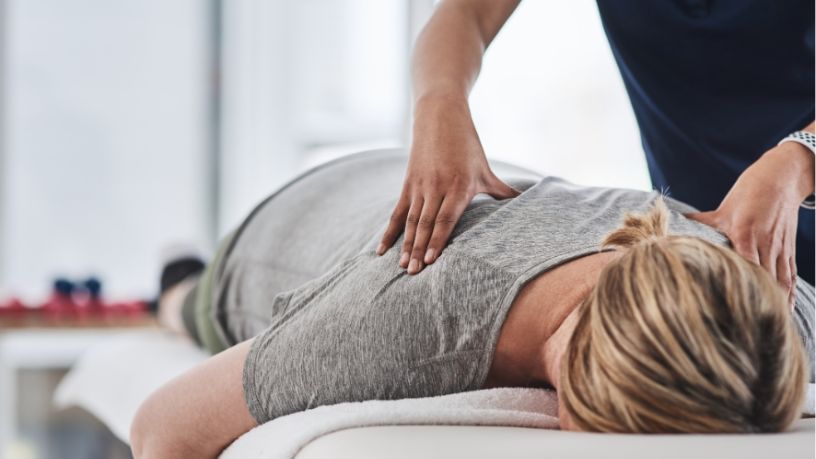Find out how different types of back surgery treat different causes of pain.
On this page
Key takeaways
There are a variety of things you can do to prepare for your surgery.
Make sure you know what to expect after back surgery.
Back surgery is a treatment for back pain, although most people with back pain don’t need surgery. Often, other treatments such as painkillers, physiotherapy, injections and psychological therapies are effective on their own or in combination. You’ll only have back surgery if these treatments don’t help, and your doctor believes surgery will.
About back surgery
There are different types of back surgery, and the operation you have will depend on the cause of your back pain. Some surgery helps to relieve back pain caused by wear and tear or osteoporosis. Other types can help if you have severe pain spreading down your leg (sciatica), caused by pressure on the nerves in your spine.1
The most common types of back surgery are described below. Your spine surgeon will discuss which type of surgery is best for you and explain what’s involved.
Lumbar decompression
Lumbar decompression (or spinal decompression) can relieve pressure on trapped nerves that cause pain in your back or legs. Decompression involves either discectomy, laminectomy or both.
Discectomy is the partial or complete removal of a disc between your vertebrae (the bones in your spine). Your surgeon may recommend this if a disc is damaged and is pressing on surrounding nerves (known as a herniated or ‘slipped’ disc).2
Microdiscectomy is a similar procedure to discectomy but involves a smaller incision than traditional discectomy surgery. If your surgeon removes the whole disc, they may suggest replacing it with an artificial disc. Ask your surgeon to explain the different options to you.3
Laminectomy surgery involves removing a small piece of bone at the back of a vertebra, called the lamina. This opens up the centre of your spinal column to relieve pressure on the nerve. Your surgeon may suggest it for spinal stenosis (a condition which causes narrowing of your spinal canal).4
Spinal fusion
This procedure joins 2 or more vertebrae together using bone grafts, screws and rods. It strengthens and stabilises your spine and prevents painful movement. Your surgeon may recommend this:
- along with decompression surgery if one of your vertebrae slips out of place
- if your spine is unstable
- if the discs between the vertebrae in your spine are worn down, which is called severe disc degeneration
- for scoliosis, where your spine bends to one side.5
Vertebroplasty and kyphoplasty
In vertebroplasty, your surgeon will inject glue-like bone cement into your vertebra to repair a compression fracture (collapsed vertebra), caused by osteoporosis or an injury. A similar procedure, called kyphoplasty, involves putting a special balloon in first, to lift the vertebra before the cement is injected.6
Percutaneous nucleoplasty (using coblation technique)
In this procedure, your surgeon will use X-rays to guide them to the right spot in your back. They’ll then pass a heated probe through a needle to destroy a damaged disc.7
Percutaneous endoscopic discectomy
In percutaneous endoscopic discectomy, a surgeon will remove tissue from a damaged disc with instruments that they’ll pass through a small cut or needle in your back.
Newer methods for back surgery, such as percutaneous nucleoplasty and percutaneous endoscopic discectomy, cause less damage to body tissues (less invasive) than standard techniques. This means you may recover quicker. Ask your surgeon if this is an option for you.8
Preparation for back surgery
Before your operation
You'll meet your surgeon or someone from their team before the operation day. They’ll run through any other treatment options and ensure you understand the expected outcome of surgery. They'll discuss what will happen before, during and after your procedure, and any pain or possible complications you might have. This is your opportunity to ask questions so you understand what will happen. If you decide to go ahead, you’ll be asked to sign a consent form.
Inform your doctor about any medications you might be taking prior to your surgery, including regular, short-term, herbal and natural medications as well as vitamins and supplements. Some medications, such as blood thinners, require close review and your doctor will give you medication instructions prior to your surgery.
Before your operation, it's worth preparing for your first days at home after surgery. You’ll need to organise for someone to collect you from hospital as you won’t be able to drive for a while. You’ll usually be able to walk after your operation but may need some bedrest first. Ask family or friends if they can help you with things like washing, dressing, cleaning and shopping. If you live alone, you may need someone to stay with you for the first few days.
On the day
If you’re having open surgery, you’ll probably have a general anaesthetic. You can’t eat anything for about 6 hours before surgery, but you may be able to drink some water until 2 hours before. Your surgeon or anaesthetist will give you advice on this.
To help prevent blood clots forming in your legs, you may be given compression stockings to wear and/or given an injection of an anticlotting medicine.9
Your surgeon will check that you've signed the consent form and are still happy to go ahead.
Back surgery procedure
Decompression surgery and spinal fusion
You’ll have a general anaesthetic for these procedures, which means you’ll be asleep throughout. Your surgeon will take X-rays to find the affected area of your back, then make a cut into your back to reach your spine. The surgery will usually take between one and 3 hours, depending on exactly what’s being done. If your operation is more complex, it can take as long as 10 to 12 hours.
In decompression surgery, your surgeon will remove sections of bone, ligaments or disc to free up the nerves in your back. If bone is removed, this is called a laminectomy. If only disc material is removed, it’s called discectomy (or microdiscectomy) surgery.
In spinal fusion, your surgeon will put a bone graft (a small piece of bone) between 2 bones in your spine (vertebrae) to fuse them together. The graft may be from elsewhere in your body, from donated bone, or it may be artificial (synthetic). They may use plates, screws and rods to keep your spine still while the bones fuse.10
Vertebroplasty and kyphoplasty
These procedures are used to fix compression fractures, usually from osteoporosis, and to strengthen bone to prevent future fractures.
You may have a general or local anaesthetic. If you have a local anaesthetic, you’ll be awake during the operation, but your doctor will offer you a sedative to relax you.
You’ll lie face down and your surgeon will put the needle into the affected area of your back (guided by X-rays). They’ll then inject bone cement into the broken bone. In kyphoplasty, your surgeon will put in a balloon temporarily to make space for the cement.11
Aftercare for back surgery
After back surgery you’ll go to a recovery room where a nurse will monitor you until you’re fully awake. You’ll have pain relief to help as the anaesthetic wears off.
You’ll probably have an intravenous (IV) drip in a vein in your arm, and you may have a catheter in your bladder, which will drain your urine into a bag. You'll have a dressing over your wound.
You’ll usually spend up to a few nights in hospital. You’ll need to spend some time resting in bed, but your hospital team will also encourage you to get up and walk around.
A nurse will give you advice about caring for your back and looking after your wound before you go home.
You’ll need to arrange for someone to drive you home, and if you live alone, ask a friend or relative to stay with you for the first few days.
Recovery from back surgery
Your recovery time from back surgery will depend on the type of surgery you've had as well as other factors such as your age and general health.
- After standard decompression surgery, you can usually expect to be pain-free and able to exercise after 6 weeks. You should be back to most normal activities within 12 weeks.
- It can take several months for bone to grow after spinal fusion. You'll be told how to move in a way that keeps your spine aligned during this time. You’ll have physiotherapy and will be able to gradually increase your activities.
- For vertebroplasty and kyphoplasty, you should be back to usual activities straight away.
Getting over open surgery
Recovering from open back surgery takes longer than procedures that don’t involve making a cut in your back. Try to keep moving and build up your activities gradually. If you feel tired, stop and rest. To start with, you’ll need help with practical tasks, such as cooking, cleaning and shopping.
Doing your physiotherapy exercises will help you get your strength and movement back and prevent stiffness. Your surgeon or physiotherapist may tell you not to do certain activities and movements up to 4 weeks after surgery. For example, they may tell you to avoid:
- heavy lifting
- twisting
- bending forward
- sitting or standing in one position for too long.
Aim to build up the amount of exercise you do, starting with light exercise, and gradually get back to normal.
Pain relief and looking after your wound
You may need pain relief in the first weeks after surgery. Make sure you discuss this with your surgeon before you leave hospital.
You'll have a dressing over your wound when you come home. Wash carefully around this to keep it dry. Your specialist will give you more specific instructions on how to take care of your wound. Your specialist will advise on when your stitches or staples need to be removed, or you may have stitches that are dissolvable and will disappear over time. When the wound has healed, you'll have a small scar.
Driving
You can usually drive about 6 weeks after surgery. But don’t drive if your painkillers make you drowsy, or before you can safely control your vehicle.
Getting back to work
How soon you can go back to work will depend on which type of surgery you had, and your job. Your surgeon or occupational health team will advise on the best timeframe for you. If your job is strenuous or involves driving or heavy lifting, you may need more time off work.
Bupa Health Programs
Discover our programs designed to help you recover and stay out of hospital where you can.
Side-effects of back surgery
Side-effects of back surgery can include pain and some discomfort around the wound. You may feel the pain deep in your back, especially when you move around. How long it takes for the pain to go will depend on the type of back surgery you’ve had.
Complications of back surgery
Complications of back surgery depend on the type of surgery you’ve had but may include the following:
- a wound infection or an infection in the tissues around your spine. If this happens, you may need antibiotics
- bleeding. If you lost a lot of blood during surgery, you may need a transfusion
- damage to nerves, blood vessels or other tissues. If the membrane covering your spine is damaged, the fluid surrounding your spinal cord (cerebrospinal fluid) can leak out. Your surgeon will fix this during surgery
- a swelling of blood (haematoma) near your wound. This may need draining.
After spinal fusion, the graft, rods and screws may break or move out of place. If this happens, you’ll need another operation to repair it. You may also need a second operation if not enough bone forms.
With vertebroplasty and kyphoplasty, the cement may leak or you may have a reaction to it.
If your symptoms come back after surgery, or you have another slipped disc, for example, you may need further surgery.
If you have any concerns about complications, talk to your surgeon about them. After you go home, contact the hospital if you have any concerns about ongoing symptoms and your recovery.
Frequently asked questions
Will I be able to play sports after my back surgery?
Yes, you can usually play sports again but only after your spine has recovered from surgery. It takes most people about 12 weeks after surgery to get back to their normal activities (excluding contact sports). Be sure to follow your surgeon’s and physio’s guidance. Start by taking short walks and after 6 weeks you may be able to try swimming as this will put very little strain and pressure on your spine.
What are the different types of back surgery?
There are different types of back surgery for different causes of back pain. Types of back surgery include discectomy, which is surgery for a ‘slipped’ disc. Other surgeries include laminectomy, which can relieve pressure on trapped nerves that cause pain in your back or legs, and spinal fusion, which can treat scoliosis, where your spine bends to one side.
How long is the recovery from back surgery?
How long it takes to recover from back surgery will depend on the type of surgery you’ve had as well as factors such as your age and general health. Recovering from open surgery takes longer than procedures that don’t involve making a cut in your back. For example, after decompression surgery, it can take about 6 to 12 weeks to recover. But for vertebroplasty and kyphoplasty, you should be back to usual activities almost straight away.
What should I not do after back surgery?
There are some things that you shouldn’t do after back surgery. Always follow your surgeon's recommendations. For example, up to 4 weeks after surgery, you may need to avoid heavy lifting, twisting or bending forward. It’s also best not to sit or stand in one position for too long.
Resources
The Royal Australasian College of Surgeons provides resources and advice for having surgery in Australia and New Zealand, plus information on finding a surgeon.
Pain Australia works towards improving the quality of life for those living with pain. Visit their website for resources and support, including their National Pain Services Directory.
This article was originally published on bupa.co.uk and has been amended in line with Australian guidelines.

At Bupa, trust is everything
Our health and wellbeing information is regularly reviewed and maintained by a team of healthcare experts, to ensure its relevancy and accuracy. Everyone's health journey is unique and health outcomes vary from person to person.
This content is not a replacement for personalised and specific medical, healthcare, or other professional advice. If you have concerns about your health, see your doctor or other health professional.
1American Academy of Orthopaedic Surgeons. (2021). Osteoporosis and spinal fractures. OrthoInfo.
2Chin, L. S. (2019). Lumbar discectomy. Medscape.
3Dowling, T. J., & Munakomi, S. (2022). Microdiscectomy. National Library of Medicine.
4Estefan, M., Munakomi, S., & Willhuber, G. O. C. (2022). Laminectomy. National Library of Medicine.
5American Academy of Orthopaedic Surgeons. (2022). Spinal fusion. OrthoInfo.
6National Institute for Health and Care Excellence. (2013). Percutaneous vertebroplasty and percutaneous balloon kyphoplasty for treating osteoporotic vertebral compression fractures. National Institute for Health and Care Excellence.
7National Institute for Health and Care Excellence. (2016). Percutaneous coblation of the intervertebral disc for low back pain and sciatica. National Institute for Health and Care Excellence.
8National Institute for Health and Care Excellence. (2016). Percutaneous transforaminal endoscopic lumbar discectomy for sciatica. National Institute for Health and Care Excellence.
9National Institute for Health and Care Excellence. (2019). Venous thromboembolism in over 16s: Reducing the risk of hospital-acquired deep vein thrombosis or pulmonary embolism. National Institute for Health and Care Excellence.
10Pakzaban, P., & Kopell, B. B. (2022). Spinal instability and spinal fusion surgery. Medscape.
11Patel, A., Petrone, B., & Carter, K. R. (2022). Percutaneous vertebroplasty and kyphoplasty. National Library of Medicine.
Further references:
American Academy of Orthopaedic Surgeons. (2022). Preparing for low back surgery. OrthoInfo.
Chartered Society of Physiotherapy. (2022). Managing your back pain. Chartered Society of Physiotherapy.
Debono, B., Wainwright, T. W., Wang, M. Y., & et al. (2021). Consensus statement for perioperative care in lumbar spinal fusion: Enhanced recovery after surgery (ERAS®) society recommendations. Spine, 46(5), 729-752.
Dydyk, A. M., Massa, R. N., & Mesfin, F. B. (2023). Disc herniation. National Library of Medicine.
Knott, L. (2022). Spinal disc problems. Patient.
Mehta, J. S. (2023). Discogenic low back pain. BMJ Best Practice.
National Institute for Health and Care Excellence. (2016). Low back pain and sciatica in over 16s: Assessment and management. National Institute for Health and Care Excellence.
Quraishi, N. A., Sahota, O., & Fairbank, J. (2023). Osteoporotic spinal compression fractures. BMJ Best Practice.
Royal College of Anaesthetists. (2019). Consent and ethics: Adults. Royal College of Anaesthetists.
Royal College of Anaesthetists. (2021). Anaesthesia explained. Royal College of Anaesthetists.
Royal College of Surgeons of England. (2024). Discectomy: What to expect after the operation. Royal College of Surgeons of England.
Tseng, M. D. (2023). Spinal stenosis. BMJ Best Practice.
Versus Arthritis. (2024). Back pain. Versus Arthritis.
Willacy, H. (2022). Spinal stenosis. Patient.
You might also like...
Understanding back pain: Causes, symptoms and treatment options
Learn what causes back pain, how to recognise symptoms, and your options for relief.
Taking control of chronic pain
Living with chronic pain can impact every aspect of your life. Here’s what you can do to take back the control.
Frozen shoulder: Symptoms, causes and treatments
Frozen shoulder is a condition where your shoulder becomes painful and stiff. Taking painkillers and doing exercises can help ease your symptoms.
Chronic pain and sleep: How to break the cycle
For those living with chronic pain, poor sleep usually comes with the territory. But it doesn’t have to. Learn how to break the cycle.





